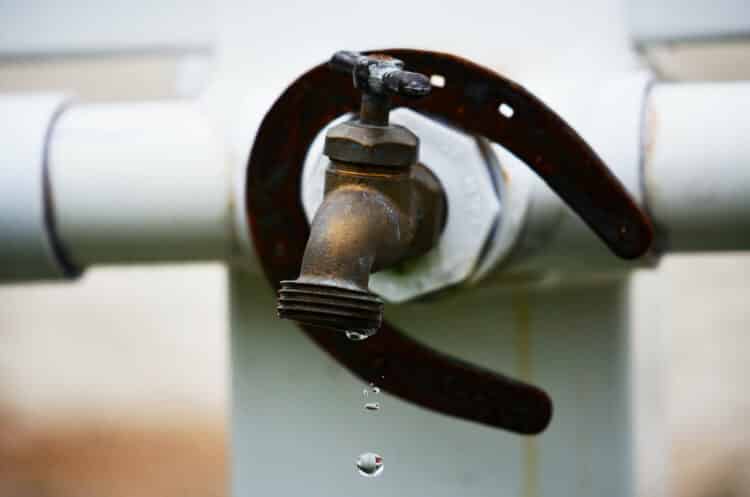
There’s nothing more frustrating than a leak you can’t find. Your biggest worry of the extensive damage it will cause if you don’t see it only adds up the pressure to find it- soon.
If you have plumbing leaks, we show you where to look, the cause of the leak, and, more importantly, a quick fix for it.
Here’s a complete and detailed guide on how to tell if you have a water leak.
Table of Contents
How to tell if you have a water leak in your shower
The best way to test if your shower door is leaking water is by splashing water all around it. If it leaks through, then you have a problem.
But that’s an easy fix. All you need to do is run a new bead of silicone sealing along the tub or floor joint. Then caulk the door frame from the inside.
Where do splash leaks come from?
Splash leaks are pretty common (the most common bathroom leak type). You get a slash leak if water seeps past the shower curtain or the door.
This leak is not as minor as it sounds. Once the water gets into the subfloor where your tub or shower meets the flooring, extensive damage can happen.
With time, if you have vinyl flooring, you can start seeing the vinyl tiles coming loose. Plus, if your subfloor is made of plywood, it will begin to delaminate and rot.
That will make replacements and other repairs costly.
But how do you spot the leak fast before this damage occurs? Here are common signs to look out for:
- Your wood finish near the shower looks chalky, and the paint starts flaking away
- Molds start growing on the walls or on the floor where the tub or shower is
- The tiles are coming loose, or the vinyl flooring is curling
- There are water stains all over the joist or the ceiling
- Lots of standing water on the floor even with a shower curtain
How to find the source of the leak
Now that you know the common signs of a splash leak, it’s time to find the source. You can readily find the source by checking for gaps near the door sweep or the rubber gaskets.
You can also search for gaps in the caulk where the flooring and the tub join. If there are no gaps there, it’s time for a little simple test.
If you have a shower door, you can take some water in your palms and splash it all over the frame and door and check for leaks.
In not more than five minutes, you can see water seeping through.
How to fix it
If you have overlapping sliding doors, ensure that they close well and adequately overlap. That will be the case if the inner doors are closest to the faucet.
If you have a shower curtain instead of a door, you can add a splash guard to prevent you from splashing the water on the floor unintentionally.
Also, ensure that you pull the curtain close entirely before showering. To fix a leaking door frame, you can consider sealing it with caulk and a new small bead of the tub by running it all around the frame.
If you have to, force the caulk into the gaps all around the frame. Then you can wipe away the excess caulk before waiting for the caulk to dry. Once you are sure it’s dry, you can carry out the splash test again.
That can confirm the effectiveness of your quick repair. If there’s caulk existing along the floor, check out for gaps. If it’s affirmative, you can scrape it away before applying a new one.
Additionally, you can try replacing the rubber gaskets or the door sweep you have in your shower. However, ensure the replacement you get is neither too big nor too small.
To be on the safe side, carry the old one to the local plumbing store and get an identical replacement.
How to tell if you have a drain leak in the shower
The best way to know whether you have a drain leak is by checking outside your drain where it connects to your shower or tub for any leaks.
Other hard to miss signs include rotting floor joists or damaged ceilings below. Also, check for damage in adjoining rooms and bathrooms and loose flooring near the tub.
Additionally, please note that these leaks can occur more often if you have shower pans or tubs made of either fiberglass or plastic. That’s because it’s easy to break the seal around the drain since these materials flex ever so slightly when you stand on them.
How to find the source of this leak type
If the access panel or an open ceiling allows you to see the drain’s underside, you can carry out a little leak test.
First, fill your tub with water partially before releasing the water. Then use a rag to plug the drain form inside a shower and then release the water. Now, look through the access panel for any leaks.
Suppose you don’t have a way to look through the underside of the drain and traps. You can form a puddle around the drain by adding enough water to it after plugging it.
You can then use a bottle of shampoo to mark where the edge of the puddle is at and then let things settle for an hour.
Once the timeline lapses, you can check if there’s any shrinkage in the water level. If you confirm there is, then your drain is leaking.
Also, remember not to use a tub stopper while carrying out the test because of these leaks. Instead, you can buy a 1-1/2-in—test plug from the home center to use in place of a tub stopper.
In place of a grate for your shower, you can use a 2-in. plug.
How do you fix this leak
Drain leaks are not a hard fix. If you can easily access the shower drain from below, you can tighten the ring nut to ensure that the drain is correctly locked on the shower pan.
You can also try replacing the drain assembly with a WingTite drain if the first option doesn’t work. If you fail to access the drain from below it, you can do so by cutting a hole in the ceiling below.
Another option involves unscrewing the drain flange from above the tub drain. You can then clean it before you apply the caulk.
You can also replace the rubber gasket beneath the drain before you screw back the flange. To be on the safe side, take the gasket with you to the home center to ensure you get the right size.
How to find and fix tile leaks in the shower
Tile leaks in the shower are commonplace. It happens when water leaks through the degrading grout and into the walls behind the tile.
If your tiling material is not high quality, the tiles can fall from the walls, the wall frame can rot extensively, and it risks damage to the joists, ceiling below, and subfloor.
So what signs should you look for to prevent extensive damage? You can check out for loose tiles, stains on the ceiling below your shower, and continued mold growth.
Also, you can check the exterior wall for paint peels if the shower is against it.
How to find the source of the leak
Finding the leak source is not difficult since you already know the cause of the leak. The best place to start looking for the head is at the caulk joints or grout.
If you find molds, then there’s a high probability you will also find gaps in them.
You can also open the access panel behind your faucet and check for any signs of wetness, dampness, and stains. This is the first place to look when you notice loose tiles behind the faucet.
How to fix the leak
You can start fixing it by getting rid of the old caulk and grout. Also, the loose tiles need to go so that you can check if the wall behind it is still solid.
You can use tub and tile caulk to reattach the tiles, grout, and caulk if it still is. However, if the wall is spongy or many tiles are loose, you need new tiles and backer boards to replace the old ones.
How to find a toilet flange leak
Toilet flange leaks happen where your toilet attaches to the waste pipe below. Every time you flush, water leaks into the flooring and can cause damage to the ceiling below flooring and rot the joists and subfloors.
How do you know it’s leaking? The most common sign to look for is water leaking out around your toilet base with every flush.
Also, if your toilet rocks even slightly with a small push, it may be leaking. That can eventually cause the wax seal between your toilet and the closet flange to break.
Other common signs are stains on your ceiling below and damaged or many loose flooring.
How to find the source of the leak
If one of the signs you found were ceiling stains, find out if it’s near the toilet. If that’s the case, then the most probable source for the leak is the flange.
You can then go ahead and remove the toilet to confirm this hunch. Now, look out for any cracking signs in the flange, broken bolts or slots, or loose flange.
Also, check if the flange is on the same level with the surrounding floor surface or below it.
How to fix it
After the thorough search you just did on the flange. It’s time to fix all the issues you confirmed. Here we go:
- If the flange is below the surrounding surface, you can fix it by installing a plastic flange right over the existing one.
- If the bolt slots are broken or the flange, you can replace it with a metal repair flange
- If your toilet rocks with slight pushes because of an uneven floor, you can use toilet shims under the toilet once you reinstall it
- If none of the problems apply to you, then reinstalling the toilet with a new wax ring can help stop the leaks
How to tell your sink rim is leaking
These types of leaks allow water to leak through the rim of the sink. With time, sink rim leaks can cause considerable damage to the countertops and cabinets in bathrooms and kitchens.
Your first sign of impending damage is finding puddles or wetness in the cabinets. You can also find water stains.
Also, the caulk around your sink will start to deteriorate, and both the faucet base and the plastic laminate near your sink coming loose.
How to find the source of the issue
You can dribble water around the sink rim and keep an eye out for a seeping. You can also check under your plastic laminate countertop for any signs of water damage like swelling using a flashlight.
How do I fix it?
The faucet base is probably loose, and all you need to do is tighten the mounting nuts. You can also consider tightening the clips right beneath the sink rim to clamp the sink to the countertop securely.
Lastly, you can scrape away the old caulk and recaulk the sink rim.
How to identify supply leaks
Under the sink, leaks like supply leaks are usually tricky to identify and fix. That’s because they are the most hidden leaks.
For instance, supply leaks happen behind the cabinet, and you can easily fail to recognize it until extensive damage occurs.
Leaking water can get into the floors, framing, and subfloor and sink base, rotting wherever it goes.
The most common signs include stains on the ceiling below and wetness, puddles, or water stains under the sink plumbing.
How to find the source of the leak
You can run the dishwasher and run a tissue to check for leaks. Or, you can dab at shutoffs and connections using a paper towel or tissue. If these come out with wet spots, you leak.
How to fix it
Fixing these leaks is usually as simple as tightening the packing nut if the drip is coming from the shutoff valve or the valve stem.
If that doesn’t work, you can replace the valve. Additionally, you tighten the compressing nut to stop the leaks.
Or you can disassemble the fitting and use Teflon joint compound to coat the ferrule before reassembling the parts again.
How to identify drain leaks in sinks
If you have drain leaks, the most probable place it occurred is the slip joints in the drainpipe or the drain itself. Since sink drains are usually far from your line of sight, it can take time to notice them.
And by that time, the damage to the flooring, ceilings below, and cabinets will already be severe.
You can look out for damaged flooring right in front of the sink or dank odor, water stains, puddles in the cabinets as the most common signs of leaking.
How to locate the source fast
You can check the waste hose connection while running and draining the dishwasher for any signs of leaks by running a tissue. If it comes out dry, you can move to the sinks.
Now fill the sink bowls with water and drain it. While at it, simultaneously run a tissue at the joints connecting the sink to the wall and check for wetness.
How to fix these leaks
If the slip joints are the ones leaking, you should first consider tightening the slip nut. If it proves ineffective, then disassemble the joint and use a Teflon joint compound to coat the washer. Afterward, you can put it back together.
If the basket strainer is the leak’s source, you can fix it by tightening the ring nut below the sink. If that doesn’t work, then it’s best to disconnect it and detach the basket strainer.
You can then use a plumber’s putty as a sealant and apply it on the bottom part of the basket’s rim before reassembling it.
How to find hidden water heater tank leaks
The most common signs of tank leaks are puddles forming near your water heater. You can find the sources by checking whether the relief valve or the drain valve is dripping.
If either or both are, then you can fix it by replacing the culprit valve. However, if you find both valves in excellent condition, then the issue is probably at the tank itself.
A leaking tank means replacing your water heater since there’s no quick fix for it. As a rule of thumb, you should take action immediately you notice the problem.
If you take too long to fix the issue, the tank can burst and flood your household without notice anytime from a couple of days later to weeks later.
Leaking washing machine supply hose
Like tank leaks, these leak types are slow but signal major damage if ignored. You can inspect the leaking supply hose for any damage, as well as the crimped metal fittings.
If there’s even slight damage that appears insignificant, you should replace the hose immediately. If not, you risk having the hose burst in your hands and not only hurting you but also releasing a continuous flow of water you have no control over.
That can eventually flood your home and damage a lot of items.
Is there are foolproof test for hidden leaks?
Most hidden leaks are usually due to a fault in the plumbing fixtures. That’s why it’s always best to start there. Check out all the plumbing fixtures in your homes, like toilets, tubs, showers, and sinks.
However, the issue can also be the water supply system. Now, a leak at this part of your home has a foolproof way of confirming it.
It’s simple. You don’t even have to hassle with the hidden pipes inside the walls. All you need to do is turn off all the faucets in your home.
If you have those drippy faucets or toilets that run between flushes, you need to close shutoff valves for this plan to work effectively.
Then, check your water meter and mark the position of the one cubic foot dial. Come back and review again after at least two hours pass. If there’s even a slight change in the dial position, then the leaky culprit is your water system.
It would be best to fix this as soon as possible to prevent damaging any part of your home.
But that’s not the only way you can know whether you have hidden leaks in your home. Here are other tips to let you know whether you have leaks:
Check your water usage
If your water usage is always exaggeratingly high, yet you are living alone or have a small family, chances are, you have hidden leaks.
You can check your plumbing system or your water supply system to find the leak and fix it immediately.
You have a spike in the bill
Always monitor your water bill. That way, you can readily note if there are any unusual spikes in the bill that you cannot explain.
For instance, if your water consumption did not change for this month, yet the bill is almost triple your previous bill, you can tell there’s something off.
The probability that a hidden leak is to blame is high. Otherwise, your water bill should be constant or have a steady rise.
Test your toilet for leaks
If you have a hunch that your toilet is leaking, there’s a simple test you can carry out to confirm it. All you need to do is take some food coloring and pour it into the toilet tank.
If after 10 minutes or so you see the coloration in your toilet bowl, then chances are, your toilet is allowing water to leak to your drain without having to flush your toilet.
Final thoughts
Hidden leaks can be anyone’s biggest cause of headaches. It’s so frustrating to know there’s a leak somewhere in your home damaging your property and increasing the water bill without being able to find it.
However, with these tips, you can find the leaks and fix them as soon as possible. More importantly, you will know not to ignore the signs when you see them.


